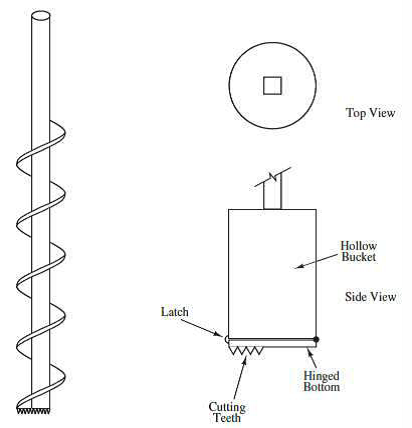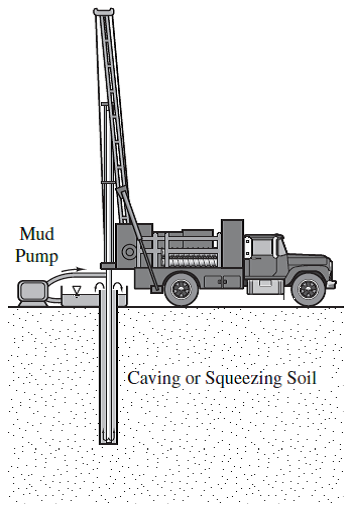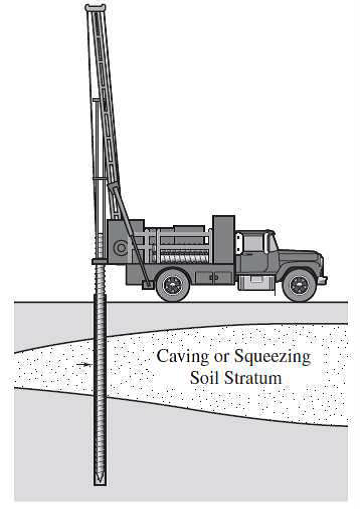

|
Read More
Date: 14-1-2023
Date: 2023-02-25
Date: 2023-02-25
|
The geotechnical engineer should implement a subsurface exploration before performing foundations designs in order to collect necessary information which will help in:
▪ Choosing type and depth of footings.
▪ Determining load-bearing capacity of the foundation.
▪ Computing the probable settlement of the structure.
▪ Identifying the location of the groundwater level.
▪ Predicting lateral earth pressure for the retaining structures.
▪ Selecting suitable construction methods for improving subsurface conditions that underlie.
a proposed structure.
The program of the subsurface exploration involves three major phases:
1) Collection of preliminary information, this phase consists of obtaining preliminary information from reliable sources.
2) Reconnaissance, in this phase the engineer should make a visual inspection of a proposed site to check natural topography of the site, see type of vegetation at the site, identify types of building nearby and the existence of any structural problems in those buildings.
3) Site Investigation, this phase comprises several steps including planning, making test boreholes, collecting soil samples at desired intervals for laboratory tests, and performing several in-situ tests.
Exploratory Borings:
Exploratory borings are a series of vertical holes drilled into the ground. Typical depth of these holes ranges from 3 to 30 m with an inside diameter varies from 75 to 600 mm. Exploratory borings are typically drilled using two drilling equipment: flight auger and bucket auger, as illustrated in Figure 1. A wide variety of drilling techniques are used to deal with caving or squeezing soils including:
1) Caving: this method involves the boring with a steel pipe to prevent the sides of the boring falling in, as shown in Figure 2a.
2) Rotary Wash Boring: this method involves filling the boring with a bentonite slurry to provide a sufficient lateral pressure on the sides of the boring, as shown in Figure 2b.
3) Hollow-Stem Auger: this method involves screwing a hollow core into the ground and obtain a soil sample by lowering sampling tools through a hollow of the auger, as shown in Figure 2c.
4) Coring: this method involves drilling through hard rock. The coring process recovers intact cylindrical specimens of the rock.

Figure 1: Types of Drilling Tools: (a) Flight Auger, (b) Bucket Auger

(a): Caving Methods

(b): Rotary Wash Auger

(c) Hollow-Stem Augur
Figure 2: Methods Deals with Caving and Squeezing Soils
There are no specific rules that define depth, number and spacing of the exploratory borings in the field. However, Sowers (1979) provided general guidelines for approximately determining depth, spacing, and a number of exploratory borings at a proposed project. Table 1 and Table 2 present these guidelines .
Table 1 – Guidelines for Spacing Exploratory Borings

Table 2 – Guidelines for Depth of Exploratory Borings

• S: number of stories
• D: anticipated depth of foundation
Soil Sampling
The purpose of making the exploratory borings is to obtain soil samples which are utilized in determining a soil profile. There are two types of soil samples:
▪ Disturbed samples (sometimes called bulk sample), and they are suitable for many purposes such as: soil classification, and proctor compaction test.
▪ Undisturbed samples (sometimes called intact sample), and they are suitable for many purposes such as: consolidation test, shear test, and triaxial test.
Groundwater Monitoring
The location and condition of groundwater table are often determined through installing an observation well. The observation well is constructed by inserting a slotted PVC pipe in a completed boring, after that the boring is backfilled with a well-graded sand and gravel, see Figure 3.

Figure 3: Schematic Diagram of Observation Well
Exploratory Trenches
Exploratory trenches are typically utilized in shallow investigations to provide more information about the upper soil layers (i.e., depth less than 3 m). Exploratory trenches are dig using a backhoe in which disturbed samples can be recovered with shovel as well as undisturbed samples can be obtained using hand-held sampling equipment.
Laboratory Testing Methods:
Disturbed and undisturbed soil samples recovered from the sites are brought to a soil mechanics laboratory to determine their engineering characteristics. The laboratory testing methods are:
▪ Consolidation Tests: provide the necessary data for settlement analyses.
▪ Shear Strength Tests: provide the necessary data to determine shear strength and stiffness.
▪ Compaction Tests: provide the necessary data to evaluate compaction characteristics.
▪ Corrosivity Tests: provide the necessary data to assess sulfate content and design appropriate protective measures.

|
|
|
|
للعاملين في الليل.. حيلة صحية تجنبكم خطر هذا النوع من العمل
|
|
|
|
|
|
|
"ناسا" تحتفي برائد الفضاء السوفياتي يوري غاغارين
|
|
|
|
|
|
|
بمناسبة مرور 40 يومًا على رحيله الهيأة العليا لإحياء التراث تعقد ندوة ثقافية لاستذكار العلامة المحقق السيد محمد رضا الجلالي
|
|
|